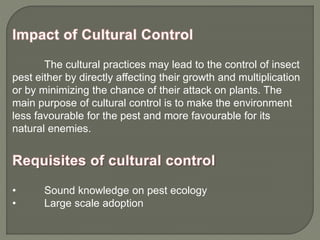Our Pestwise Diaries
Our Pestwise Diaries
Blog Article
6 Easy Facts About Pestwise Described
Table of ContentsPestwise for BeginnersSome Ideas on Pestwise You Should KnowPestwise Things To Know Before You Get ThisThe Greatest Guide To PestwiseSome Ideas on Pestwise You Should KnowPestwise Fundamentals ExplainedThe 30-Second Trick For Pestwise

Q. Specify "integrated insect administration" (IPM) and listing a number of feasible control methods that might be used in an IPM method. A. Integrated insect administration is the incorporating of ideal pest control tactics into a single strategy to reduce insects and their damage to an acceptable degree. Bug control strategies might include: host resistance, organic control, cultural control, mechanical control, sanitation, and chemical (chemical) control.
Everything about Pestwise
What can you do to maintain the bugs you are trying to regulate from becoming resistant to the chemicals you use? A. Insect resistance can be lowered by using integrated parasite management and turning the kinds of chemicals used.
Bugs are an important hazard to the farming company, and integrated bug administration aids growers address and reduce these dangers. Integrated parasite management uses a number of approaches in facility, hence being a more efficient option to the concern. Mosquito Control. Particularly, removing hostile chemical approaches permits reducing injury to individuals and the setting by utilizing all-natural and much safer options instead
Excitement About Pestwise
The objective of integrated parasite administration is to decrease this harm and control acceptable invasion levels instead of remove all undesired populaces. This is why it is very important to comprehend what measures are warranted in each case and usage aggressive ones just when other incorporated administration strategies do not work. Integrated administration reduces the negative repercussions of a non-IPM technique, and the main advantages of IPM Advantages of IPM.
A proper understanding of the invasion scope identifies if the trouble ought to be resolved. are the next components of an IPM program because it is essential to realize if the microorganisms make possible risks and choose the integrated monitoring choices or the specific chemical usage. intend to minimize infestations by using various agronomic techniques.
The Main Principles Of Pestwise
Integrated management options in an IPM program start with safer to much more hostile ones. The above-mentioned integrated management facets aid recognize just how to prepare and execute an IPM program step by step: Monitor your plants regularly.

To name a few, IPM cultural methods include the following field management methods: dirt therapy; option of ideal plants; plant turning; interplanting or strip chopping; choice of planting days; weed control; usage of catch plants. Beneficial dirt problems quicken plant development, and strenuous plants are extra resistant to invasions. Termite Treatment. In integrated insect administration, dirt screening assists comprehend if the field appropriates for the manufacturing of this or that crop, and afterwards apply the doing not have nutrients to make certain plant healthy and balanced development
All about Pestwise
No-till techniques help prevent dirt erosion, contributing to sustainable farming. Nevertheless, when tilling is required, it is advised to conduct it in the be up to subject them to all-natural opponents and extreme weather condition. Healthy seed startings and seeds predetermine effective crop advancement, so it is necessary to select pest-free planting material with strong roots.
Hence, amongst other applications, crop turning can be effectively used as an incorporated insect monitoring approach. Vermin spread slower if rows of different crop kinds divide their host plants in intercropping or strip chopping, which is additionally used in the integrated insect monitoring system. additional info Conversely, infestations enhance when plants of the exact same crop type or family grow with each other.
, as well as tomatoes. Growing catch plants in patches is an additional option for IPM intercropping. This integrated pest management approach recommends drawing in insects to specific plants and after that managing them with chemical or mechanical strategies.
Pestwise for Beginners
Obstacles are normal examples of physical IPM techniques. Let's take a more detailed take a look at them. Removing or choosing pests out manually is a time and labor-consuming alternative that is commonly used in integrated monitoring and chemical-free farming. Mature pests or their eggs and larvae are collected by hand and damaged.

Division of Plant Sciences. College of Missouri. Dirt solarization is an efficient integrated management strategy to sanitize the area by heating it in an all-natural way. This incorporated monitoring method suggests an usual means of destroying insects by predators, parasitoids, virus, and other organic control agents (also known as hostile organisms). The role of biological control in IPM is to.
The Of Pestwise
With time, their populace transformed out to be a real problem to farmers together with native kangaroos or dingoes. The cane toad is another instance illustrating integrated organic control failing hereof when it refused to hunt the target varieties and came to be a parasite itself. Parasitoids create on or within their hosts to at some point kill them after maturing.
Report this page